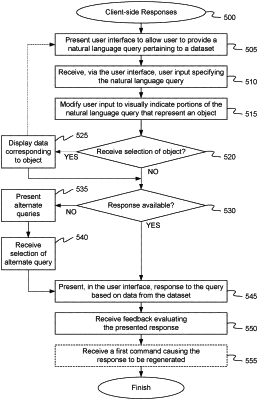| CPC G06F 16/90344 (2019.01) [G06F 16/24578 (2019.01); G06F 16/90332 (2019.01); G06F 16/9038 (2019.01); G06F 40/205 (2020.01); G06F 40/40 (2020.01); G06N 20/00 (2019.01)] | 14 Claims |

|
1. A method comprising:
presenting a user interface to allow a user to provide a natural language query pertaining to a dataset, wherein the dataset is associated with a data object model comprising a plurality of objects;
receiving, via the user interface, first user input specifying the natural language query;
modifying, in the user interface, the first user input to visually indicate one or more portions of the natural language query that each represent one of the plurality of objects;
modifying, in the user interface, a visual indication of one portion of the one or more portions of the natural language query specified by the first user input to a selectable interface element including a plurality of selectable options associated with the one portion of the one or more portions, wherein the selectable interface element is part of a visual indication of the natural language query;
presenting, in the user interface, a response to the natural language query, the response being based on data from the dataset, the data corresponding to the one of the plurality of objects; and
receiving, via the user interface, second user input indicating a first command corresponding to the response, the first command causing the response to the query to be recreated until a second command is received.
|